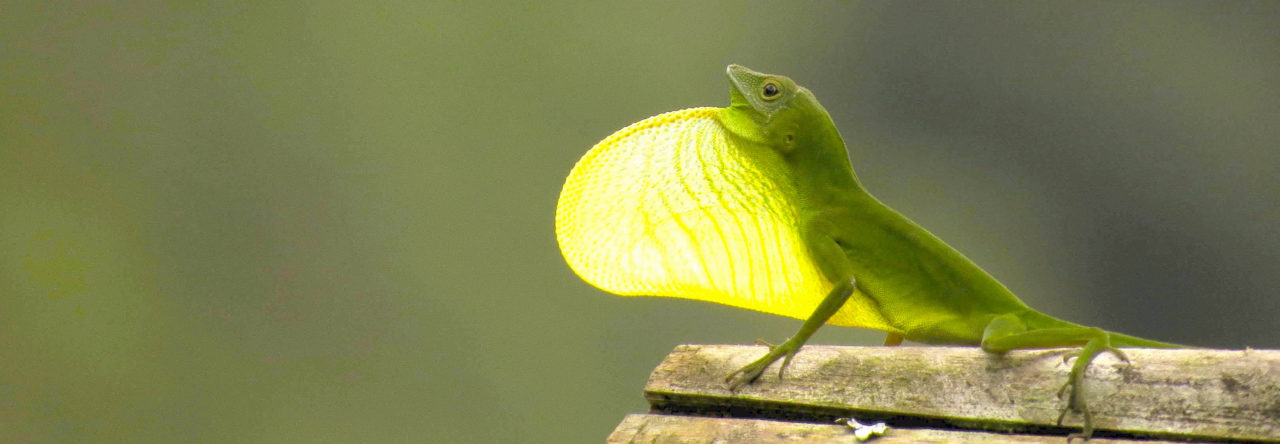In the pantheon of anoles, Anolis maynardi has a special place as one of the funniest looking species around. To the casual observer it appears that someone has taken an A. carolinensis (to which A. maynardi is closely related), grabbed it by the tip of the snout, and pulled it forward. The purpose of this pincer-like proboscis, much more extreme in males than in females (which are smaller), is unknown. Indeed, until recently, just about everything about the species was unknown.
Anolis maynardi is endemic to the tiny island of Little Cayman. Remarkably, although visible in the distance, the nearby island of Cayman Brac does not harbor the species. At least naturally. In 1987, A. maynardi was reported at the Cayman Brac airport, most likely a beachhead resulting from a stowaway on an island-hopping airplane. Another survey in 1991 still found it only near the airport, and nothing further was known.
 A new paper in Breviora (of which I am a co-author) starts to lift the shroud of mystery around this enigmatic green anole. Habitat data from both Little Cayman and Cayman Brac indicate that it is a typical trunk-crown ecomorph, usually found in trees or other places well above the ground. It is dimorphic in many respects, again typical of trunk-crown anoles. Surveys on Cayman Brac indicate that it is now widespread.
A new paper in Breviora (of which I am a co-author) starts to lift the shroud of mystery around this enigmatic green anole. Habitat data from both Little Cayman and Cayman Brac indicate that it is a typical trunk-crown ecomorph, usually found in trees or other places well above the ground. It is dimorphic in many respects, again typical of trunk-crown anoles. Surveys on Cayman Brac indicate that it is now widespread.
Many questions still remain. First and foremost, why the long snout? One other species shows this morphology, A. longiceps, another member of the carolinensis species group on the even more remote and tiny island of Navassa, between Hispaniola and Cuba. These species may be closely related, but phylogenetic work to date is ambiguous (if the two are, indeed, sister taxa, one has to wonder how they got to be on two such out-of-the-way locales, and nowhere else). The Breviora paper indicates that males have substantially greater bite force than females, perhaps as a result of their jaw morphology (but they are also larger, as well as schnozzier). Whether the long snout also makes them adept at picking up little objects, as if they had a forceps on their front end, or quicker at swiping sideways as prey flies by, remains to be seen. Also, whether sexual selection may have had something to do with this evolutionary elongation awaits investigation.
Finally, a species of conservation concern simply because it is native to a single, small island, A. maynardi is also an invasive species on Cayman Brac, where the local subspecies of A. sagrei (luteosignifer) is endemic. How the two species are interacting, and whether the green anole’s presence has any negative impacts on the brown, also needs study.
- Evolution in Real Time on Lizard Island - March 23, 2025
- Spider Snags Adult Anolis osa - March 22, 2025
- An Homage to the Green Anoles of New Orleans - March 21, 2025



Wes Chun
Thank you for the photos and information on this obscure species. At one time, Seidel and Franz (1994) contained the only known photo (to me, at least) of A. maynardi. Some online sleuthing will turn up additional photos of this interesting species, including Blair Hedges’s CaribHerp website.
If anyone out there has any information to share about the carolinensis-group anoles A. brunneus of Crooked/Acklins and A. fairchildi of Cay Sal, that would be much appreciated.
Jonathan Losos
As you know, there’s very little data available on either species. Schoener included A. brunneus in his 1975 Ecological Monographs paper, and de Queiroz and I included it in our 1987 Biol. J. Linn. Soc. paper. As far as I know, nothing is known about A. fairchildi, although I think Blair Hedges may have collected it.